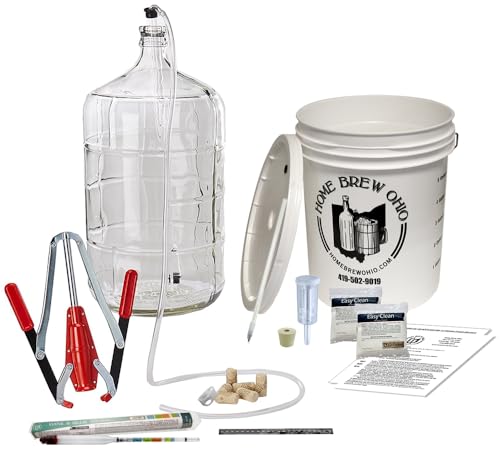Paulie vino
Senior Member
I started a cherry wine from 2 lb. Of fresh cherries from my tree. And four 32 oz. Bottles of store-bought cherry juice without preservative. It fermented for about 4 days and the SG was getting low so I put I under airlock days and then it stopped at 1.002. I ran into some hydrogen sulfur smell prior to this which was address by adding more fermaid o. The SG has stayed steady for about 4 days now. I stirred it today and we'll see if it restarts. Any suggestions? Should I take off the airlock?
My notes are below. Any help would be appreciated. Thanks
2 lbs of montemorcy cherries from my tree and upstate tree.
32 oz bottle of Lakewood pure tart cherry not from concentrate
3x 32 oz bottle Knudsen tart cherry from concentrate
0.9 g lallzyme ex
No extra water added
1.25 g go ferm protect
1.1 gram moncharet yeast
6/16- de stemmed all cherries and crushed by hand in pot. Started to pull pits but that was too time consuming so I stopped and left most in. Wanted to use only cherries but didn't have enough so I added juice from store. Added 0.9 g lallzyme ex and will wait a few hours to add yeast
220g sugar added in and stirred and another 234g.
Starting sg before sugar 1.052. after sugar 1.090. ferm calc seems to be accurate
Used 1/4 cup hot tap water at 98 degrees to make yeast starter (1.25 g go ferm and 1.1 g yeast)
915pm pitched yeast. Covered pot with kitchen towel
6/17- 645am sg 1.086. added 0.7g of fermaid O (will add other 0.7g at 1/3 sugar depletion around 14 brix or 1.059 sg).
6/18- 830am very foamy, smells a little like rotten eggs, swamp gas. Sg 1.054. stirred very well which helped with the smell a little. Added 0.9g of fermaid k and stirred in again. Smell was better but still present.
830 pm- still smells like sulfur. Splash racked by pouring into 6 galllon bucket and back into pot 4 times. added0.42g fermaid O stirred well. Smell was better after, will check tomorrow morning. Sg was around 1.046 ( hard to see because of foam in cylinder)
6/19- 730 pm sg 1.006
6/20- 945pm sg 1.002. Smells better. Tastes good, tart and yeasty
6/21- racked by pouring into 1 gallon carboy with white stopper and airlock, extra was racked into small wine bottle and stopped with vacuum seal pump top for temporary storage. SG 1.002
6/24- SG 1.002 still, foam residue on top of wine like it's still fermenting but SG hasn't changed.
6/26- SG unchanged. Stirred wine to see if it restarts
My notes are below. Any help would be appreciated. Thanks
2 lbs of montemorcy cherries from my tree and upstate tree.
32 oz bottle of Lakewood pure tart cherry not from concentrate
3x 32 oz bottle Knudsen tart cherry from concentrate
0.9 g lallzyme ex
No extra water added
1.25 g go ferm protect
1.1 gram moncharet yeast
6/16- de stemmed all cherries and crushed by hand in pot. Started to pull pits but that was too time consuming so I stopped and left most in. Wanted to use only cherries but didn't have enough so I added juice from store. Added 0.9 g lallzyme ex and will wait a few hours to add yeast
220g sugar added in and stirred and another 234g.
Starting sg before sugar 1.052. after sugar 1.090. ferm calc seems to be accurate
Used 1/4 cup hot tap water at 98 degrees to make yeast starter (1.25 g go ferm and 1.1 g yeast)
915pm pitched yeast. Covered pot with kitchen towel
6/17- 645am sg 1.086. added 0.7g of fermaid O (will add other 0.7g at 1/3 sugar depletion around 14 brix or 1.059 sg).
6/18- 830am very foamy, smells a little like rotten eggs, swamp gas. Sg 1.054. stirred very well which helped with the smell a little. Added 0.9g of fermaid k and stirred in again. Smell was better but still present.
830 pm- still smells like sulfur. Splash racked by pouring into 6 galllon bucket and back into pot 4 times. added0.42g fermaid O stirred well. Smell was better after, will check tomorrow morning. Sg was around 1.046 ( hard to see because of foam in cylinder)
6/19- 730 pm sg 1.006
6/20- 945pm sg 1.002. Smells better. Tastes good, tart and yeasty
6/21- racked by pouring into 1 gallon carboy with white stopper and airlock, extra was racked into small wine bottle and stopped with vacuum seal pump top for temporary storage. SG 1.002
6/24- SG 1.002 still, foam residue on top of wine like it's still fermenting but SG hasn't changed.
6/26- SG unchanged. Stirred wine to see if it restarts




















































 your in need of multiple containers,
your in need of multiple containers, 